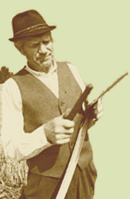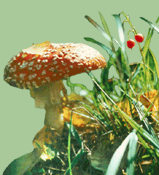Wooden guides lead us to mire walks
Piret Pungas takes a glance at information boards designed to help out hikers: do they do their job? The author has looked at 18 hiking trails in Estonian bogs and swamps, and recorded and analyzed the contents of information boards. It can be concluded that most information boards set high expectations for the hiker: one should be quite tall, with very good eyesight, have professional knowledge of botany, zoology and geography, good imagination and skills of the Estonian language. In the article, several shortcomings of Estonian practices regarding information bogs are outlined. In addition, the author has provided a number of suggestions to keep in mind when designing the look and contents of an information board.
Phosphorite under electronic microscope
Ivar Puura and Liisa Lang share the newest information about our important natural resource, by describing the composition and fine structure of shelly phosphorite. As phosphorite mining has become an issue again, it is important that we know as much as possible about its composition. The shelly phosphorite or Obolus phosphorite contains a number of fossils. Most noteworthy and numerous of these are lingulate brachiopods. The authors have put these under electronic microscope and elaborate on the composition of these Paleozoic life forms.
The Baers law and meanders as a key for restoring flowing waterbodies
Kalle Kroon reminds that rivers themselves are able to create the most valuable water and bank habitats. Meanders are among the most valuable river habitats of all, providing excellent conditions for many species, including trouts. But in several cases meanders have been cut off by new canals. The author focuses on one such example, the River Oostriku.
Three sandstone denudations of the Tartu County have been measured
Ain Vellak gives an overview of new measurement data about denudations of Rookse, Täte and Paelätte. The article is supplemented with numerous photos and detailed graphic material to illustrate the location and nature of the denudations.
Estonian Nature enquires
Jaak Laineste explains what is a QR-code and what can it be used for.
Mari-Liis Kitter writes about how the State Forest Management Centre has designated good mushroom and berry forests.
Seducing jasmine
Urmas Kokassaar has a good opinion about jasmine and its useful qualities for making tea, oil, and other products. Jasmine is mostly known for its white flowers that have a very intense smell.
The protein that breaks the cell into pieces
Rainer Kerge compares the programmed cell death or apoptosis to waste sorting: the demolished pieces of a cell are mostly reused. The programmed cell death is started by the organisms decision when some cells have grown old, are hurt or just unnecessary. Apoptosis produces cell fragments called apoptotic bodies that phagocytic cells are able to engulf and quickly remove before the contents of the cell can spill out onto surrounding cells and cause damage.
Interview: Ðparo, a hot-hearetd man at icy Arctic. Toomas Jüriado has intreviewed Dmitri Ðparo, a polar researcher.
Rhodotus palmatus: a fungal rarity on elm tree
Kuulo Kalamees writes about the only known Agaricales of Estonia to have close trophic relations with elm trees. There is information about three habitats of the species in Estonia. It can be easily recognized due to its salmon or peach colour and netted surface.
Poisonous mushrooms and related intoxications V. Amanitin intoxication
Kuulo Kalamees continues introducing poisonous mushrooms, paying special attention to the genus Amanita. The intoxication can be caused by five species of the genus: the fly agaric, the royal fly agaric, the panther cap, the jewelled amanita and the European blusher all these are described in detail in the overview.
Hiking trail: The stone giants of the Pahkla rocket base
Katre Palo suggests visiting some stone giants on the border of the Harju and Rapla counties. One of these stones is even called the King of Estonian stones. There are altogether six large stones in the surroundings of the former Pahkla rocket base. The article gives instructions about how to reach these, as there is no official hiking trail.
Onygena equina: three new habitats in 17 years
Erast Parmasto takes a look at a fungus which has become as rare as bone remnants of domestic animals in our forests, as the species grows on decaying animal bones.
The mysterious forest witch does exist
Villu Anvelt introduces wryneck: a bird that imitates snakes. In old times, the little bird with strange look and voice was associated with witchcraft. It remains to be one of our most mysterious and little-known bird. The author sheds some light on its lifestyle and the numerous photographs speak for its look.
Spuhl-Rotalia suggested natural preventive measures
Aimur Joandi looks back at instructions from an old book called Domestic berries by Jaan Spuhl- Rotalia (1897). He stresses the importance of several birds and rove beetles in our gardens. A number of these instructions would be wise to follow even nowadays, 115 years later.
|


![[IN ENGLISH]](images/gb.gif)





